Crystal Palace
The modern Crystal Palace football club was formed by workers who maintained the grounds and played their home games in this magnificent setting. A set of strips was donated by Aston Villa and claret and blue remained Palace's traditional colours (often described as cardinal red and blue) until the 1970s.
The club joined the Southern League and became founder members of the new Third Division, winning the title at the first attempt. After four difficult years in Division Two, Palace dropped back into Division Three 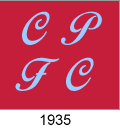 (South) in 1925 and remained there for the next 33 years. Their 1925 kits, incidentally, featured light blue stockings with claret tops, a pattern that did not otherwise appear until the mid-1950s.
(South) in 1925 and remained there for the next 33 years. Their 1925 kits, incidentally, featured light blue stockings with claret tops, a pattern that did not otherwise appear until the mid-1950s.
The first recorded evidence of the team wearing a crest was in the 1935-36 season, when the club's initials were embroidered onto their shirts.
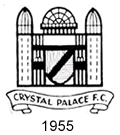 In the late 1930s the club adopted plain white jerseys in an attempt to change their fortunes but to no avail. Traditional claret and blue shirts were restored in 1949. These were used until 1955 when white shirts with distinctive claret and blue trim appeared. These featured a new crest representing the famous facade of the original Crystal Palace and were used until 1964.
In the late 1930s the club adopted plain white jerseys in an attempt to change their fortunes but to no avail. Traditional claret and blue shirts were restored in 1949. These were used until 1955 when white shirts with distinctive claret and blue trim appeared. These featured a new crest representing the famous facade of the original Crystal Palace and were used until 1964.
In 1958 Palace were in the new Fourth Division with little prospect of success. Clad in a distinctive white shirt with claret and blue bands, Palace won promotion in 1961. Towards the end of the 1963-64 season, they switched to playing in their "lucky" amber change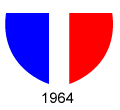 kit for home games: this seemed to do the trick as they won promotion to Division Two.
kit for home games: this seemed to do the trick as they won promotion to Division Two.
In 1964 Palace played Real Madrid in a friendly to celebrate the installation of their new floodlights. For the next two seasons they wore an all white kit similar to the European Champions adorned with a simple crest in red, white and blue. The official crest continued to be a sketch of the original Crystal Palace but this did not appear on the teams shirts.
Champions adorned with a simple crest in red, white and blue. The official crest continued to be a sketch of the original Crystal Palace but this did not appear on the teams shirts.
Claret and blue was reintroduced in 1966; initially the shirts were light blue with claret candy stripes but the colours were reversed in 1967. This fondly remembered strip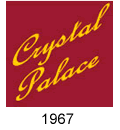 featured the club's name embroidered in full in gold script, making for an attractive contrast.
featured the club's name embroidered in full in gold script, making for an attractive contrast.
In 1969, Palace were promoted once again and took their place in Division One for the first time. Clearly out of their depth and with limited financial resources, Palace managed to stave off relegation for four years before they went into free-fall, and dropped straight down into the Third Division. In 1971 another favourite strip was introduced, basically all white with broad claret and light blue panels on the chest. The first version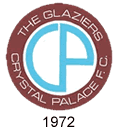 bore the gold embroidered script but when a new version was introduced in 1972, with a narrow white stripe separating the claret and blue, his was replaced by a circular badge in modernist style. Included in the design was the team's traditional nickname, "The Glaziers."
bore the gold embroidered script but when a new version was introduced in 1972, with a narrow white stripe separating the claret and blue, his was replaced by a circular badge in modernist style. Included in the design was the team's traditional nickname, "The Glaziers."
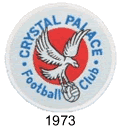 The charismatic Malcolm Allison was brought in as manager in late 1973 and while he could not keep the club in the Second Division, he did transform them, laying the foundations for future success. Out went the old badge and nickname to be replaced by the more dramatic "Eagles." The traditional claret and light blue colours were ditched in favour of red and blue. To add to what would now be called a re-branding exercise, numbers were worn on shirt sleeves in 1973-74 and the following season the new badge adorned the sleeves instead.
The charismatic Malcolm Allison was brought in as manager in late 1973 and while he could not keep the club in the Second Division, he did transform them, laying the foundations for future success. Out went the old badge and nickname to be replaced by the more dramatic "Eagles." The traditional claret and light blue colours were ditched in favour of red and blue. To add to what would now be called a re-branding exercise, numbers were worn on shirt sleeves in 1973-74 and the following season the new badge adorned the sleeves instead.
After narrowly missing promotion three times, Allison called it a day and Terry Venables took over as manager. Venables steered Palace all the way back into the First Division with a side dubbed "the Team of the Eighties." They failed to live up to this reputation and were relegated in 1981 after only two seasons at the top. Venables left the club in his usual controversial circumstances and Palace, now almost bankrupt, descended into chaos.
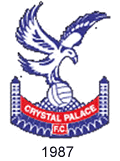 The club's saviour turned out to be Steve Coppell, recently retired as a player and appointed to his first managerial job in 1984, a job he retained until 1993. Coppell brought stability and proved to be an outstanding judge of young talent. Many of the youngsters he signed for a pittance were sold on for multi-million pound transfer fees, bringing much needed revenue to the club. With Coppell in charge, Palace adopted a revised crest in 1987 and returned to the First Division in 1989. The following year they reached the FA Cup final for the first time. A year later, Palace finished third behind Arsenal and Liverpool. In 1992, however, the club was relegated and Coppell resigned. Since then the club has moved between the two top divisions with bewildering regularity, sporting a a series of eye catching and original kits, not all of which have met with approval from fans. Their 2003-04 kit was, for example dubbed the "Ronald MacDonald" kit because of the hooped sleeves.
The club's saviour turned out to be Steve Coppell, recently retired as a player and appointed to his first managerial job in 1984, a job he retained until 1993. Coppell brought stability and proved to be an outstanding judge of young talent. Many of the youngsters he signed for a pittance were sold on for multi-million pound transfer fees, bringing much needed revenue to the club. With Coppell in charge, Palace adopted a revised crest in 1987 and returned to the First Division in 1989. The following year they reached the FA Cup final for the first time. A year later, Palace finished third behind Arsenal and Liverpool. In 1992, however, the club was relegated and Coppell resigned. Since then the club has moved between the two top divisions with bewildering regularity, sporting a a series of eye catching and original kits, not all of which have met with approval from fans. Their 2003-04 kit was, for example dubbed the "Ronald MacDonald" kit because of the hooped sleeves.
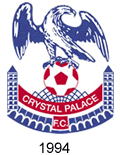 In 2005, the club's centenary year, a special kit, chosen by supporters and modeled on the classic 1971 kit was worn in a pre-season friendly and two home league games. In 2006 the crest was again revised, combining the original eagle and football design from 1973 with the Crystal Palace motif from 1987.
In 2005, the club's centenary year, a special kit, chosen by supporters and modeled on the classic 1971 kit was worn in a pre-season friendly and two home league games. In 2006 the crest was again revised, combining the original eagle and football design from 1973 with the Crystal Palace motif from 1987.
In 2009-10, the club was placed in administration for the second time after the chairman, Simon Jordan failed to attract new investment, HMRC took out a winding up order over unpaid taxes and the players were paid late on two occasions. The ten point penalty took the team from a comfortable mid-table position in the Championship to just above the relegation zone but they retained their place on the last day of the season. A consortium of wealthy supporters, CPFC 2010, bought both the freehold on the ground and the club itself during the close season to ensure the club's survival.
